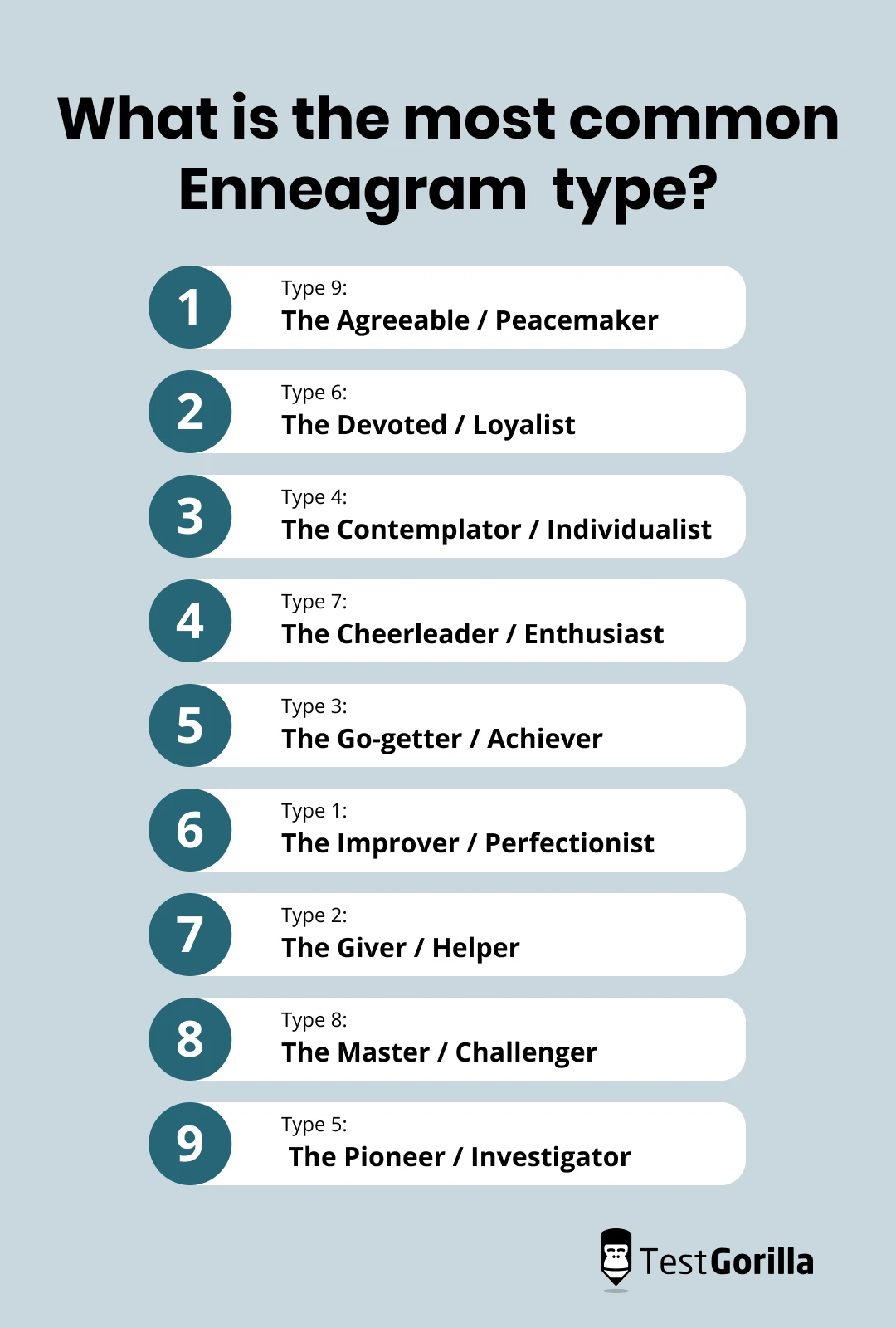Every employee, regardless of their role, skills, or experience, has different personality traits and values that dictate how they work and collaborate with others.
Choosing the best candidate during hiring campaigns can be a struggle if you don’t look beyond hard skills. It’s important to determine how each applicant will perform in the current environment and if they will collaborate effectively with teams and supervisors.
To assist with this, you can use a pre-employment personality test. This helps you learn about applicants’ personalities, assess how they see the world, and if they have the right qualities to thrive in your organization.
The Enneagram test is a well-known personality test. It helps employers gauge a candidate's personality type and is often used before the interview process.
In this article, we’ll list the most to least common Enneagram personality types and what each type indicates about a candidate so you can hire the best-suited individual for your company.
Table of contents
What is the most common Enneagram type?
Many experts believe that the nine Enneagram types are evenly distributed across the global population. However, surveys of test-takers have shown that some types are more popular than others.
An extensive Enneagram population distribution study was conducted by enneagram-personality.com to ascertain the most and least common Enneagram types.
Let’s dissect the results starting from the most popular, and see what it means for your hiring campaign.
1. Type 9 – The Agreeable/Peacemaker
More than 16% of the 189,957 results assessed in the study were Type Nine. These personalities are agreeable employees who consider everyone’s point of view. They value harmony and aim to avoid conflicts.
Key traits:
Non-judgmental and accepting
Good listeners
Strong collaboration skills
Interpersonal skills
Nines will thrive in stable jobs where they are valued. They want to drive positive change, mediate conflicts, and support others.
Examples of ideal professional fields for Nines are counseling, teaching, and healthcare.
However, they can struggle with creating structure, become too complacent, and ignore personal needs to avoid conflict.
Learn more about the Enneagram Type 9.
2. Type 6 – The Devoted/Loyalist
Closely behind Type Nines in popularity is Type Six. Devoted types are driven by security.
Key traits:
Committed, practical workers
Prepared for any situation
Rule-abiding
Sixes need consistent work environments where they can feel secure about the future. Examples of compatible roles for Sixes include managerial positions at established companies, or that of dentist, paralegal, or banker.
Type Six workers can become demotivated if their peers or bosses ignore them or are unreliable. They also might focus too much on worst-case scenarios.
Learn more about the Enneagram Type 6.
3. Type 4 – The Contemplator/Individualist
The main goal of Type Four is to be unique. Type Fours value creativity and authenticity and want their work to be meaningful.
Key traits:
Self-introspective
Innovative
Empathetic
Strive to make an impact
In some cases, Type Fours can be moody and self-absorbed. They tend to do well in entertainment, journalism, photography, design, and other related fields.
Learn more about the Enneagram Type 4.
4. Type 7 – The Cheerleader/Enthusiast
Driven by excitement and relentless curiosity, Type Sevens are optimistic idealists that are spontaneous and fun-loving. They are great to be around and are always full of ideas.
Key traits:
Imaginative
Can intrigue and inspire peers
Great team player
Sevens work best in fast-paced roles where every day brings something different. This could involve jobs like that of pilot, tour guide, content creator, chef, trainer, or artist.
On the downside, Type Sevens can struggle to focus on one task at a time and might repress or ignore problems.
Learn more about the Enneagram Type 7.
5. Type 3 – The Go-getter/Achiever
Type Three personalities are mainly focused on success and admiration.
Key traits:
Highly driven
Cherish personal achievements
Adaptable
Productive
Threes can work well in a range of roles, some more extrovert-oriented (like advertising and event planning), and others more introvert-oriented (like business, politics, and law).
They are image-conscious, friendly, and often have packed schedules. However, they crave recognition and reassurance, so they can sometimes value their professional accomplishments over their sense of self or personal needs.
Learn more about the Enneagram Type 3.
6. Type 1 – The Improver/Perfectionist
Type One employees have high standards and want to do everything perfectly.
Key traits:
Dedicated
Rule-follower
Attention to detail
Advisor
Type Ones do well in detail-oriented roles where communication is straightforward and expectations are clear. Example roles include that of accountant, editor, surgeon, architect, and real estate agent.
Since they are always focused on improving, they can sometimes become overly critical of themselves or their coworkers.
Learn more about the Enneagram Type 1.
7. Type 2 – The Giver/Helper
Type Twos are empathetic and always willing to lend a hand. They want to be liked and are incredibly giving.
Key traits:
Helpful
Selfless
Build and nurture relationships
Twos want to bring joy to others and would enjoy working in the non-profit, medical, and hospitality industries. Since they put others first, they tend to ignore their own needs and might not set boundaries.
Learn more about the Enneagram Type 2.
8. Type 8 – The Master/Challenger
Type Eights are assertive leaders who like to take control and make decisions.
Key traits:
Great leadership skills
Tackle challenges efficiently
Charismatic
Eights work best in leadership roles, as executives or in senior management, for example, or roles involving a lot of independence, such as a journalist or an event planner.
However, when things don’t go their way, Eights can be controlling, confrontational, or intimidating.
Learn more about the Enneagram Type 8.
9. Type 5 – The Pioneer/Investigator
Only 4.8% of the results were Type Five, making it the rarest Enneagram type. Fives are innovators that always want to learn.
Key traits:
Endless curiosity
Knowledge and expertise-focused
Analytical, perceptive, and self-reliant
Value privacy and time alone
Ideal roles for Fives include that of analyst, engineer, freelancer, researcher, scientist, and web developer.
Fives are reclusive and will get demotivated around too many people. They tend to be detached from their emotions, focusing on growing their knowledge and expertise instead.
Learn more about the Enneagram Type 5.
Can someone’s Enneagram change over time?
When using the Enneagram test for hiring, recruiters may wonder if a person’s Enneagram type will change over time.
According to the Enneagram framework, a person’s Enneagram type will not change. It’s a permanent part of your personality that is formed at an early age based on your upbringing and socialization.
While behavior may vary in different situations, a person’s core motivations will likely remain the same.
Is the Enneagram test accurate?
While a personality test can’t be 100% accurate, the Enneagram test has been backed by many experts to be a useful guide during the hiring process.
However, the Enneagram test should not be used to make final decisions during hiring. It provides subjective indicators of a candidate’s personality and can assist hiring managers when crafting interview questions.
The test should be used as one of many methods to gain general insights into your candidate’s personality, motivation, and working methods.
Why use Enneagram tests in hiring campaigns
TestGorilla’s Enneagram test helps hiring teams quickly gain an understanding of a candidate’s personality traits. The test was developed by subject-matter experts and has passed a 28-step quality-control process before publication.
The 10-minute test, which candidates can complete on any device, outlines an applicant’s worldview and core beliefs, which indicate how they might react to different scenarios at work.
Results are automatically generated and displayed on an intuitive dashboard that streamlines collaboration and speeds up decision-making. The Enneagram test can be combined with 300-plus skills and personality tests to find the right candidate.
The test results enable hiring managers to place candidates in teams and roles where they fit best. It can also help supervisors guide new employees toward success in your organization. By interpreting an individual’s personality type, you can identify their strengths and learn how to help them grow.
Combine the Enneagram test with skills testing
Understanding a candidate’s personality type is vital in making effective hiring decisions that lead organizations to success. Choosing candidates with Enneagram types that are compatible with team members and managers can create a productive and cohesive work culture.
Type Nine is the most common Enneagram type, while Type Five is the least. All nine types have their strengths and weaknesses, which can make them more or less suitable for specific job roles.
Hiring managers can use TestGorilla’s in-depth Enneagram test combined with other job-specific skills tests to find the best candidate for any position.
Sign up for TestGorilla’s Free plan today or watch a product tour to see how our platform can streamline your organization’s hiring processes.
Related posts
Hire the best candidates with TestGorilla
Create pre-employment assessments in minutes to screen candidates, save time, and hire the best talent.
Latest posts
The best advice in pre-employment testing, in your inbox.
No spam. Unsubscribe at any time.

Hire the best. No bias. No stress.
Our screening tests identify the best candidates and make your hiring decisions faster, easier, and bias-free.
Free resources
This checklist covers key features you should look for when choosing a skills testing platform
This resource will help you develop an onboarding checklist for new hires.
How to assess your candidates' attention to detail.
Learn how to get human resources certified through HRCI or SHRM.
Learn how you can improve the level of talent at your company.
Learn how CapitalT reduced hiring bias with online skills assessments.
Learn how to make the resume process more efficient and more effective.
Improve your hiring strategy with these 7 critical recruitment metrics.
Learn how Sukhi decreased time spent reviewing resumes by 83%!
Hire more efficiently with these hacks that 99% of recruiters aren't using.
Make a business case for diversity and inclusion initiatives with this data.


















